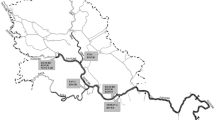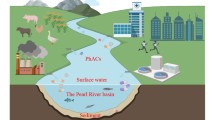Abstract
Pharmaceutical compounds were increasingly detected in environmental matrices but little is known whether these compounds would transport to coastal zones via watersheds. Three typical tidal rivers in southeastern China were selected and 15 surface sediment samples (0–10 cm) were collected along a 50-km tidal section of each river. Surface sediment samples were frozen-drying and then extracted for pharmaceutical compounds by an accelerated solvent extraction system. The pharmaceutical compounds in extracts were scanned using a high-performance liquid chromatography/tandern mass spectrometry (HPLC-MS/MS). Three hundred and thirty compounds from nine pharmaceutical groups were detected with signal-to-noise above three (detectable level) in the surface sediments, of which 186 compounds were with a signal-to-noise above ten (measurable level). Of all, 291 and 80 compounds were detectable and measurable in all the three rivers, respectively. The Jiulong River showed a high load of pharmaceutical compounds in surface sediment than other two rivers. Of the nine pharmaceutical groups, the antihistamines and detoxification group and anti-infective drug group contributed five dominant compounds in the surface sediments in all the three rivers. Natures of pharmaceutical compounds rather than the sediment properties (pH, EC, and total carbon content) might influence their residues. The incredible number and intensity of pharmaceutical residues were detected in tidal surface sediments of the three rivers indicating that the pharmaceutical contamination should be strongly considered in China. Source identification and eco-toxicity assessment should be taken into account in the future study. Therapeutic medicine managements need to be strictly improved at a watershed scale to reduce loads of pharmaceuticals into aquatic ecosystems.




Similar content being viewed by others
References
Baquero F, Martínez JL, Cantón R (2008) Antibiotics and antibiotic resistance in water environments. Curr Opin Biotechnol 19:260–265
Carballa M, Omil F, Lema JM, Llompart M, García-Jares C, Rodríguez I, Gómez M, Ternes T (2004) Behavior of pharmaceuticals, cosmetics and hormones in a sewage treatment plant. Water Res 38:2918–2926
Carballa M, Fink G, Omil F, Lema JM, Ternes T (2008) Determination of the solid-water distribution coefficient (Kd) for pharmaceuticals, estrogens and musk fragrances in digested sludge. Water Res 42:287–295
Chen H, Li X, Zhu S (2012a) Occurrence and distribution of selected pharmaceuticals and personal care products in aquatic environments: a comparative study of regions in China with different urbanization levels. Environ Sci Pollut Res 19:2381–2389
Chen N, Wu J, Hong H (2012b) Effect of storm events on riverine nitrogen dynamics in a subtropical watershed, southeastern China. Sci Total Environ 431:357–365
Chen YS, Zhang HB, Song J, Luo YM (2012c) Occurrence and dissipation of veterinary antibiotics in two typical swine wastewater treatment systems in east China. Environ Monit Assess 184:2205–2217
Chen YS, Cao QM, Deng SB, Huang J, Wang B, Yu G (2012d) Determination of pharmaceuticals from various therapeutic classes in dewatered sludge by pressurized liquid extraction coupled with high performance liquid chromatography and tandem mass spectrometry (HPLC-MS/MS). Intern J Environ Anal Chem doi:10.1080/03067319.2012.717271
Chen YS, Zhang HB, Luo YM, Song J (2012e) Occurrence and assessment of veterinary antibiotics in swine manures: a case study in East China. Chin Sci Bull 57:606–614
Chiaia-Hernandez AC, Krauss M, Hollender J (2013) Screening of lake sediments for emerging contaminants by liquid chromatography atmospheric pressure photoionization and electrospray ionization coupled to high resolution mass spectrometry. Environ Sci Technol 47:976–986
China Medicine Economic Information Net (CMEIN) (2007) Chinese Medical Statistical Yearbook (2006–2007). China Medicine Economic Information Net, Beijing
Daughton CG, Ternes TA (1999) Pharmaceuticals and personal care products in the environment: agents of subtle change? Environ Health Perspect 107(S6):907–938
Dolliver H, Gupta S (2008) Antibiotic losses in leaching and surface runoff from manure-amended agricultural land. J Environ Qual 37:1227–1237
Ellis JB (2006) Pharmaceutical and personal care products (PPCPs) in urban receiving waters. Environ Pollut 144:184–189
Esplugas S, Bila DM, Krause LGT, Dezotti M (2007) Ozonation and advanced oxidation technologies to remove endocrine disrupting chemicals (EDCs) and pharmaceuticals and personal care products (PPCPs) in water effluents. J Hazard Mater 149:631–642
Fujian Bureau of Statistics (2012) Fujian Statistical Yearbook. China Statistics Press, Beijing
Göbel A, Thomsen A, McArdell CS, Alder AC, Giger W, Theiss N, Löffler D, Ternes TA (2005) Extraction and determination of sulfonamides, macrolides, and trimethoprim in sewage sludge. J Chromatogr A 1085:179–789
Grung M, Källqvist T, Sakshaug S, Skurtveit S, Thomas KV (2008) Environmental assessment of Norwegian priority pharmaceuticals based on the EMEA guideline. Ecotoxicol Environ Saf 71:328–340
Hughes SR, Kay P, Brown LE (2013) A global synthesis and critical evaluation of pharmaceutical datasets collected from river systems. Environ Sci Technol 47: 661–677
Jelic A, Gros M, Ginebreda A, Cespedes-Sánchez R, Ventura F, Petrovic M, Barcelo D (2011) Occurrence, partition and removal of pharmaceuticals in sewage water and sludge during wastewater treatment. Water Res 45:1165–1176
Jjemba PK (2006) Excretion and ecotoxicity of pharmaceutical and personal care products in the environment. Ecotoxicol Environ Saf 63:113–130
Jones OA, Voulvoulis N, Lester JN (2006) Partitioning behavior of five pharmaceutical compounds to activated sludge and river sediment. Arch Environ Contam Toxicol 50:297–305
Kaplan S (2013) Review: pharmacological pollution in water. Crit Rev Env Sci Technol 43:1074–1116
Kolpin DW, Furlong ET, Meyer MT, Thurman EM, Zaugg SD, Barber LB, Buxton HT (2002) Pharmaceuticals, hormones, and other organic wastewater contaminants in U.S. streams, 1999–2000: a national reconnaissance. Environ Sci Technol 36(6):1202–1211
Krascsenits Z, Hiller E, Bartal M (2008) Distribution of four human pharmaceuticals, carbamazepine, diclofenac, gemfibrozil, and ibuprofen between sediment and water. J Hydrol Hydromech 56:237–246
Kristiansson E, Fick J, Janzon A, Grabic R, Rutgersson C, Weijdegård B, Söderström H, Larsson DG (2011) Pyrosequencing of antibiotic-contaminated river sediments reveals high levels of resistance and gene transfer elements. PLoS One 6:e17038. doi:10.1371/journal.pone.0017038
Kümmerer K (2009a) The presence of pharmaceuticals in the environment due to human use—present knowledge and future challenges. J Environ Manage 90:2354–2366
Kümmerer K (2009b) Antibiotics in the aquatic environment—a review—part I. Chemosphere 75:417–434
Murray KE, Thomas SM, Bodour AA (2010) Prioritizing research for trace pollutants and emerging contaminants in the freshwater environment. Environ Pollut 158:3462–3471
Nieto A, Borrull F, Marcé RM, Pocurull E (2009) Determination of personal care products in sewage sludge by pressurized liquid extraction and ultra high performance liquid chromatography-tandem mass spectrometry. J Chromatogr A 1216:5619–5625
Ort C, Lawrence MG, Rieckermann J, Joss A (2010) Sampling for pharmaceuticals and personal care products (PPCPs) and illicit drugs in wastewater systems: are your conclusions valid? A critical review. Environ Sci Technol 44:6024–6035
Prado N, Ochoa J, Amrane A (2009) Biodegradation and biosorption of tetracycline and tylosin antibiotics in activated sludge system. Process Biochem 44:1302–1306
Santos LH, Araújo AN, Fachini A, Pena A, Delerue-Matos C, Montenegro MC (2010) Ecotoxicological aspects related to the presence of pharmaceuticals in the aquatic environment. J Hazard Mater 175:45–95
Scheurer M, Ramil M, Metcalfe CD, Groh S, Ternes TA (2010) The challenge of analyzing beta-blocker drugs in sludge and wastewater. Anal Bioanal Chem 396:845–856
Schlüsener MP, Bester K (2008) Behavior of steroid hormones and conjugates during wastewater treatment—a comparison of three sewage treatment plants. CLEAN—Soil Air Water 36:25–33
Smital T, Luchenbach T, Sauerborn R, Hamdoun AM, Vega RL, Epel D (2004) Emerging contaminants—pesticides, PPCPs, microbial degradation products and natural substances as inhibitors of multixenobiotic defense in aquatic organisms. Mutation Research/Fundamental and Molecular Mechanisms of Mutagenesis 552:101–117
Speltini A, Sturini M, Maraschi F, Profumo A, Albini A (2011) Analytical methods for the determination of fluoroquinolones in solid environmental matrices. TrAC Trends Anal Chem 30:1337–1350
Stuer-Lauridsen F, Birkved M, Hansen LP, Lützhøft HC, Halling-Sørensen B (2000) Environmental risk assessment of human pharmaceuticals in Denmark after normal therapeutic use. Chemosphere 40:783–793
Sui Q, Huang J, Deng SB, Yu G, Fan Q (2010) Occurrence and removal of pharmaceuticals, caffeine and DEET in wastewater treatment plants of Beijing, China. Water Res 44:417–426
Ternes TA, Herrmann N, Bonerz M, Knacker T, Siegrist H, Joss A (2004) A rapid method to measure the solid-water distribution coefficient (Kd) for pharmaceuticals and musk fragrances in sewage sludge. Water Res 38:4075–4084
Topp E, Monteiro SC, Beck A, Coelho BB, Boxall AB, Duenk PW, Kleywegt S, Lapen DR, Payne M, Sabourin L, Li H, Metcalfe CD (2009) Runoff of pharmaceuticals and personal care products following application of biosolids to an agricultural field. Sci Total Environ 396:52–59
Wenzhou Bureau of Statistics (2012) Wenzhou Statistical Yearbook. China Statistics Press, Beijing
Yamamoto H, Hayashi A, Nakamura Y, Sekizawa J (2005) Fate and partitioning of selected pharmaceuticals in aquatic environment. Environ Sci 12:347–358
Yamamoto H, Nakamura Y, Moriguchi S, Nakamura Y, Honda Y, Tamura I, Hirata Y, Hayashi A, Sekizawa J (2009) Persistence and partitioning of eight selected pharmaceuticals in the aquatic environment: laboratory photolysis, biodegradation, and sorption experiments. Water Res 43:351–362
Zhang D, Lin L, Luo Z, Yan C, Zhang X (2011) Occurrence of selected antibiotics in Jiulongjiang River in various seasons, South China. J Environ Monit 13:1953–1960
Zhang X, Zhang D, Zhang H, Luo Z, Yan C (2012) Occurrence, distribution, and seasonal variation of estrogenic compounds and antibiotic residues in Jiulongjiang River, South China. Environ Sci Pollut Res 19:1392–1404
Zheng S, Qiu X, Chen B, Yu X, Liu Z, Zhong G, Li H, Chen M, Sun G, Huang H, Yu W, Freestone D (2011) Antibiotics pollution in Jiulong River estuary: source, distribution and bacterial resistance. Chemosphere 84:1677–1685
Acknowledgments
This study was financially supported by “Knowledge Innovation Program” of Chinese Academy of Sciences (KZCX2-YW-JC402).
Author information
Authors and Affiliations
Corresponding author
Additional information
Responsible editor: Ester Heath
Electronic supplementary material
Below is the link to the electronic supplementary material.
ESM 1
(DOC 492 kb)
Rights and permissions
About this article
Cite this article
Chen, Y.S., Yu, S., Hong, Y.W. et al. Pharmaceutical residues in tidal surface sediments of three rivers in southeastern China at detectable and measurable levels. Environ Sci Pollut Res 20, 8391–8403 (2013). https://doi.org/10.1007/s11356-013-1871-y
Received:
Accepted:
Published:
Issue Date:
DOI: https://doi.org/10.1007/s11356-013-1871-y




